This is the third weekly round-up of some really nice photography from various facebook and other glass web sites.
Make sure you visit the Fresh Peach Gallery which represents the best of the best pictures from 2012.
See a Listing of affiliated FOHBC Bottle Clubs
![]() This is the second e-mail that I have received from one of our important bottle clubs that concerns me greatly. I was able to touch on the topic in my latest FOHBC President’s Message (see below) in the latest issue of Bottles and Extras. I would like to hear your thoughts. Thanks
This is the second e-mail that I have received from one of our important bottle clubs that concerns me greatly. I was able to touch on the topic in my latest FOHBC President’s Message (see below) in the latest issue of Bottles and Extras. I would like to hear your thoughts. Thanks
Ferdinand Meyer V (FOHBC President)
To whom it may concern,
The Apple Valley Bottle Collectors Club (AVCC), after almost 40 years, is disbanding. With a lot of our older members dying off and not able to recruit new members, we have decided to close the doors. We through a big Christmas Party, but still have some funds left over that we would like to donate to FOHBC.
Please let me know where I can send a check.
Thanks,
Rich
President, Acting Treasure, Show Chairman and Newsletter Publisher
Apple Valley Bottle Collectors Club
Winchester, Virginia
Alan (DeMaison – FOHBC Business Manager),
Not sure if you are the right person to contact or not. If not, please pass on accordingly. I am the current President of the Pennsylvania Bottle Collectors Association. A club that “back in the 1970’s had over 200 members. I recently acquired a first year collection of newsletters revealing how dynamic the club was in the beginning. We are down to “about” 20 members. Maybe 10-12 are active? Most are getting up there in years and have been instrumental in keeping the club alive. At 46 years old, I am probably the youngest member. I “desperately” need to develop a “realistic” plan to grow our membership before we disappear entirely. My first approach is to develop a simple web site so we can post meeting dates/times, location etc… As we gain interest from someone, we will have somewhere to direct them for information about our club. Does the FOHBC provide any assistance with the development of a web site? I am even willing to personally pay for this development. I doubt we have enough members to come up with the needed funds. Can you point me in the right direction?
In addition…..any ideas with regards to attracting new members? I “personally” believe that my age group is probably a good target age for new membership. I am at a point where the kids have moved out, my career is stable and there is time to reflect back on American history and get back to hobbies. I’m not sure younger people would have an interest. Several club members have expressed a desire to bring back the “York” bottle show. I think this is a great goal but we currently do not have enough members to make this happen. I cannot do it on my own and I have a full time+ job. I did visit the Baltimore Bottle Club for ideas. They have strong membership numbers and enough people to keep the club dynamic. Any assistance from FOHBC to help save the PABCA is be appreciated.
Regards,
Tom Grove
Pennsylvania Bottle Collectors Association
Dover, Pennsylvania
I look forward to hearing some ideas. In this “day and age” a web site is almost a necessity “in my opinion”. Any local interest in bottles needs to be pulled to a site via a Google search. Currently an Internet search would track down a long time member and co-author of the York bottle book, Don Hartman at his home. This is good but a web site detailing what the club is all about would be better. I am not a web site designer. The new FOHBC web site is super!!
A few ideas for soliciting new members that other club members have expressed.
A weekend set up in Bedford Street Antiques in Carlisle, Pa with a focus on antique bottles.
A weekend set up at the local Mall or even Historical Society with a focus on antique bottles.
I “personally” continue to present a program called “Backyard Archeology” that has been well received but generates new privy digs not club members. To date I have given this to several Historical Societies, Senior Clubs and even an adult learning program for Penn State (OLLI). Google…Tom Grove…Privy Digger…and you should see a local Newspaper Article.
I would like to see an updated version of the York Bottle Book published. Club members feel it would be too much money.
Bring back the York bottle show. There are many folks who speak fondly of this event. I never experience this show.
Of course, if we start to pull in new members and do not have interesting programs, we will be back to square #1.
Thanks for getting the word out. I do not want to be the last President of the Pennsylvania Bottle Collectors!
Tom Grove
Response from Los Angeles Club President Dave Maryo
Hello Tom,
Our Los Angeles club had some membership problems over the last decade. I did not realize how close our club was to ending after so many years when I became president of the club. The membership had dwindled over the years when people moved away we did not get new members to replace them. We had a website at the time but it was rarely updated. I took over the website in 2009 and started updating the website with a new message every month. The website update takes time and effort. Ferdinand makes the website business look easy as he updates the Peachridge Glass and FOHBC websites on nearly a daily basis. But those updates take time and effort.
You are right that the website makes a difference. Over the last couple of years the Los Angeles club has picked up nearly a dozen members that found our club through the website. Some of the new members are much younger than I would have expected. We have two new members in our club that joined in the last couple years. One is a college student that is studying glassblowing and the other is a young lady collecting sodas that is just a few years away from being a teenager. Many younger folks are interested in bottles. Bottle shows also help keep the membership alive. The Los Angeles club has had 46 bottle shows since 1966.
Our website is hosted by IX Webhosting. They do a good job of hosting our site and have tools that allow me to update the website without expensive software that is required to manage some websites. They may be able to help you to create a website. There are other options like having a website on a some of the internet provider’s servers. I would not suggest using the internet providers “free” websites. The free sites are not protected and can be easily hacked and redirected. This can happen with a secure server too, but it is less likely. Our cost for the website with the secure server is around $200 dollars every two years. That includes the web address – in our case for the Los Angeles club it is LAHBC.org. In order to keep the web address we pay for the address every two years at about $20. The cost of the website is not cheap. Be prepared to spend a few hours a month updating the website if you start one. I work “full time +” as well and finding time for just a couple additional hours each month can be a challenge. You can have a website without updating it, but it does not draw as much interest as a site that has something new each time you visit. That is what makes Peachridge Glass such an active site.
If you would like to talk about the website and club membership issues give me a call on the weekend when I have more time. My time zone is 3 hours behind East Coast time.
Best Regards,
Dave Maryo
LAHBC President & FOHBC West Region Director
Los Angeles Historical Bottle Club
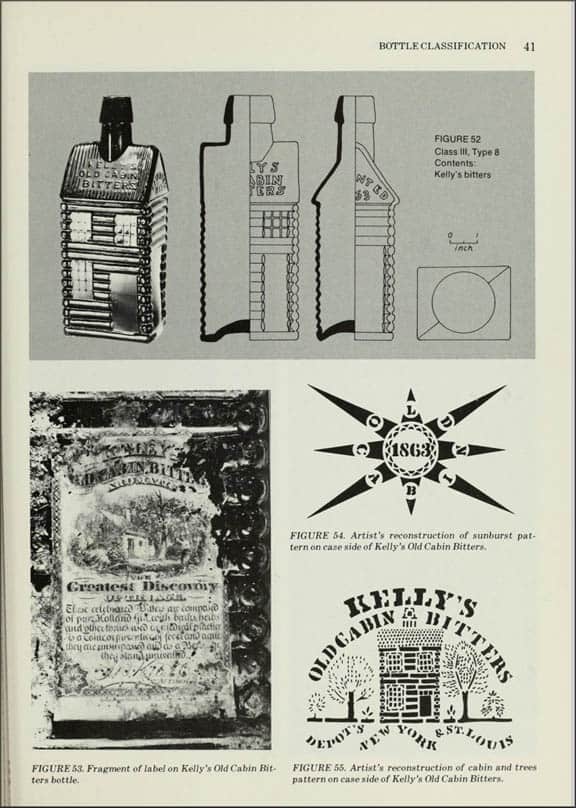
From The Bertrand Bottles – A Study of 19th-Century Glass and Ceramic Containers by Ronald R. Switzer. Published by the National Park Service (Department of Interior) in 1974. This book is one of the classic works in the field of historic archaeology as it pertains to bottles. This page is dedicated to the Kelly’s Old Cabin Bitters that were found on the Bertrand
![]() The Kelly’s Old Cabin Bitters is a dramatic example of a figural cabin with a story. With a number of great examples that have been found in mining camps, privies and shipwrecks, a Kelly’s is extremely desirable for all bitters and figural collectors alike. Just about every serious collector wants a Kelly’s at some point.
The Kelly’s Old Cabin Bitters is a dramatic example of a figural cabin with a story. With a number of great examples that have been found in mining camps, privies and shipwrecks, a Kelly’s is extremely desirable for all bitters and figural collectors alike. Just about every serious collector wants a Kelly’s at some point.
Kelly’s is also about two partners who dodged Federal taxes as they produced whiskey and called it bitters. These partners were in the thick the Great Whiskey Ring that involved President Grant in 1875 and this scandal pretty much ended the Kelly’s era.
John H. Garnhart (sometimes spelled “Garnhard”, see below) began a wholesale liquor business in 1854. He was a whiskey man by trade. He was a “rectifier” who took raw spirits, added other ingredients and sold them. Among the spirituous products he apparently concocted with James B. Kelly’s collaboration was Old Cabin Bitters.
In 1862, Garnhart put out Old Cabin Bitters. Garnhart partnered with James B. Kelly of New York in 1863. This collaboration made the Kelly brand famous. Within one month of operation the Old Cabin Bitters name was changed to the Kelly’s Old Cabin Bitters. This pretty much places the Old Cabin Bitters slightly ahead of a Kelly’s time-wise.
J. H. Garnhard (business timeline 1854-1869)
J. H. Garnhard (1854), John H. Garnhart (1857-1866), J. H. Garnhard & Co. (1869) 185-188 N 2nd (1854-1859), 108 N 2nd (1866), 411-413 N 2nd (1869)
Garnhart & Connor, (John H. Garnhart and Benson G. Connor), domestic liquors, 188 N. 2nd
Note found: William H. Harlan, of John H. Garnhart & Company, doing business in Denver March ’59, (first) is “of St. Louis, Missouri” on this date, but gives Power of Attorney to John H. Garnhart to conduct his Denver business. Not sure whether this is a pioneer, or only a non-resident businessman of Denver in 1859. He could have been a resident in early part of year, and returned to States in February. This is interesting as Kelly’s have been found in Colorado, Montana and Texas.
Garnhart & Kelly (business timeline 1864-1874)
Garnhart & Kelly (1863-1865), John H. Garnhart (1867-1868), J. H. Garnhart & Co. (1870-1874) 164 N 2nd (1864), 108 N 2nd (1865), 411-413 N 2nd (1867-1872), 19-21 S 2nd (1874) *also 118 Liberty (see below)
Note found: Letter from B. General C. Sullivan to Provost Marshal, St. Louis: He is suspicious about shipped 80 bbl. whiskey, 1 box drugs, 10 oz. quinine, all shipped by Garnhart and Kelly and off-loaded from the “Belle Memphis” – Missouri’s Union Provost Marshal Papers – 04-15-1863
The Kelly products were marketed all over the United States. They were bottled in New York and St. Louis and have been found throughout United States including Colorado, Montana and Texas. According to Steve Sewell, the bottles were made at the Whitney Glass Works in Glassboro New Jersey. (Confirmation required)
On March 22, 1870, John Garnhart was issued design patent 3,936 on his bottle. It seems another bottle very similar to his design turned up early in 1870. This bottle was embossed with the following Holtzermann’s Patent Stomach Bitters. The bottle like the Kelly’s was in the shape of and very similar in detail to their bottle. The Kellys Old Cabin Bitters lasted until 1874 when quite a few bitters and whiskey manufactures went out of business due to a great scandal.
The exposure of the Great Whiskey Ring of 1875 rocked Washington D.C. and indeed the entire country like few national scandals before or since. On May 10, Federal agents stormed into the offices of nine St. Louis distilleries, seized illicit whiskey and box loads of records, and arrested their proprietors. Simultaneous arrests occurred in Cincinnati, Milwaukee and Chicago. Ultimately, indictments were issued against 240 whiskey-makers, government officials and others; 110 were found guilty. Most of them went to jail. Thus ended a massive scheme to defraud the U.S. of excise taxes on distilled spirits. The fallout from the raids would roil the Nation for months and reach right into the White House. (Jack Sullivan)
When the May 10 raid occurred, Garnhart was one of those arrested. His company disappeared forever from St. Louis city directories. For one year, Adler, Furst & Co. was listed in directories as “successor to J. H. Garnhart & Co.”, then it too disappeared. My research has failed to determine the fate of Kelly but his Cabin Bitters brand vanished about the same time. (Jack Sullivan)
Read: A Bitters Bottle, the “sylph,” and a President, by Jack Sullivan – Special to The Potomac Pontil – May 2006
Read: ULYSSES S. GRANT His Whiskey History, by Jack Sullivan – Special to Bottles and Extras, January | February 2007
The Carlyn Ring and W.C. Ham listing in their Bitters Bottles Supplement is as follows:
K 21 KELLY’S OLD CABIN BITTERS, Circa 1863 – 1870
// s // KELLY’S / OLD CABIN / BITTERS // PATENTED ( au ) // 1863 //
KELLY’S / OLD CABIN / BITTERS // PATENTED ( au ) / 1863 //
L…Kelly’s Old Cabin Bitters, J. B. Kelly & Co., New York
9 5/8 x 3 3/8 x 2 3/4 (5 1/4)
Cabin rectangular, LTC, Applied mouth, Amber – Common; Yellow, Yellow olive, Yellow green, and Deep olive green, Rare. Known with Metallic pontil mark
Notes: Daily Illinois State Register (Springfield), July 3, 1864
Drug Catalogs: 1872 Melliers and 1878 CB & Co.
Design Patent: No. 3,926 dated March 22, 1870 by John H. Garnhart of St. Louis.
A number of specimens were dug in Montana, Texas and Colorado.
The Riverboat Bertrand bound for Ft. Benton, Montana, sunk north of Omaha in 1865. It was raised in 1968. Many cases of bottles were discovered. Among the salvaged artifacts were cases of Kelly’s Old Cabin Bittters, including a significant number of green examples, as well as Drake’s plantation Bitters, Hostetters Bitters, Schroeder’s Bitters and Schroeder’s Spice Bitters. Read: Looking at some of the Bitters Bottles on the steamboat Bertrand – Part 2
All bottles in this type contain 25 ounces of 23 proof Kelly’s Old Cabin Bitters and are molded to represent log cabins. The front and back sides bear three mold-impressed windows and a door. Corrugated roof panels which form the shoulders on the front
and back are embossed:
“KELLYS / OLD CABIN / BITTERS.” The remaining two
sides bear plain panels for labels, topped with five relief logs and a triangular-shaped space under the pitch of the roof embossed: “PATENTED / 1863.” The bottle necks are cylindrical.
Kelly’s bitters crates show some variation in stenciling; two consignees and one retailer are represented. The stencils appear as follows:
“KELLEY’S / OLD CABIN BITTERS / DEPOTS NEW YORK & ST. LOUIS”, sides: (red) eight point sunburst with a letter at the base of each ray, lettered: “O L D / C A B I N.” At the center of the sunburst appears the date “1863″. Some cases have no marks on their sides. Tops: “GLASS WEIGHT / THIS SIDE UP WITH CARE / G. P. DORRIS / VIRGINIA CITY / MONTANA, TY.”; or,
“WORDEN AND CO. / HELL GATE”; or, “FROM / H. A. RICHARDS / WASHINGTON / 57, / BOSTON / GIN COCKTAIL / WORDEN AND CO. / HELL GATE.; Dimensions, Type 8: height, 9 1/8 inches; base, 2 3/4 by 3 7/16 inches; diameter of neck (outside), 1 inch, (inside), 3/4 inch.
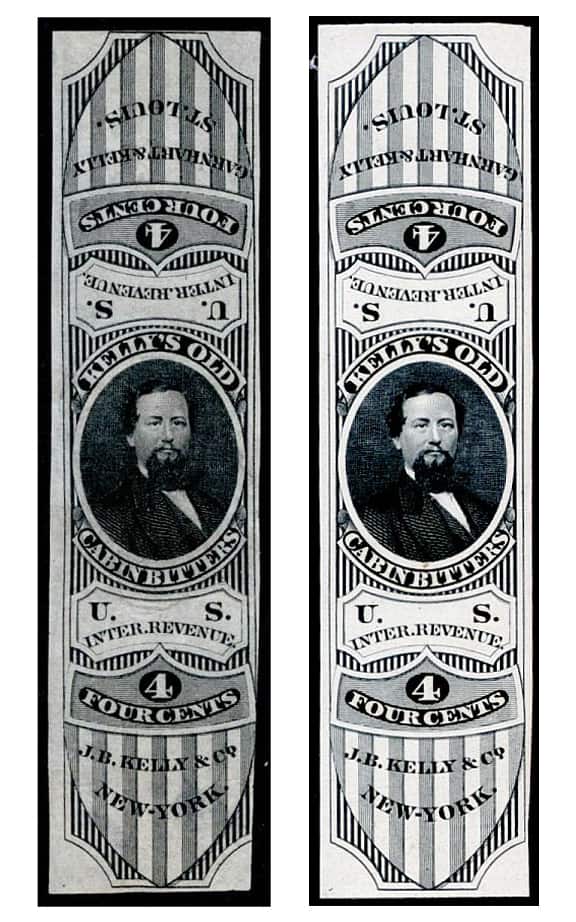
The J.B. Kelly & Co. proprietary stamp was first issued in March of 1864, and last issued on December 3, 1870. 445,125 were issued, all on old paper. The item on the right is a plate proof. – rdhinstl’s Page
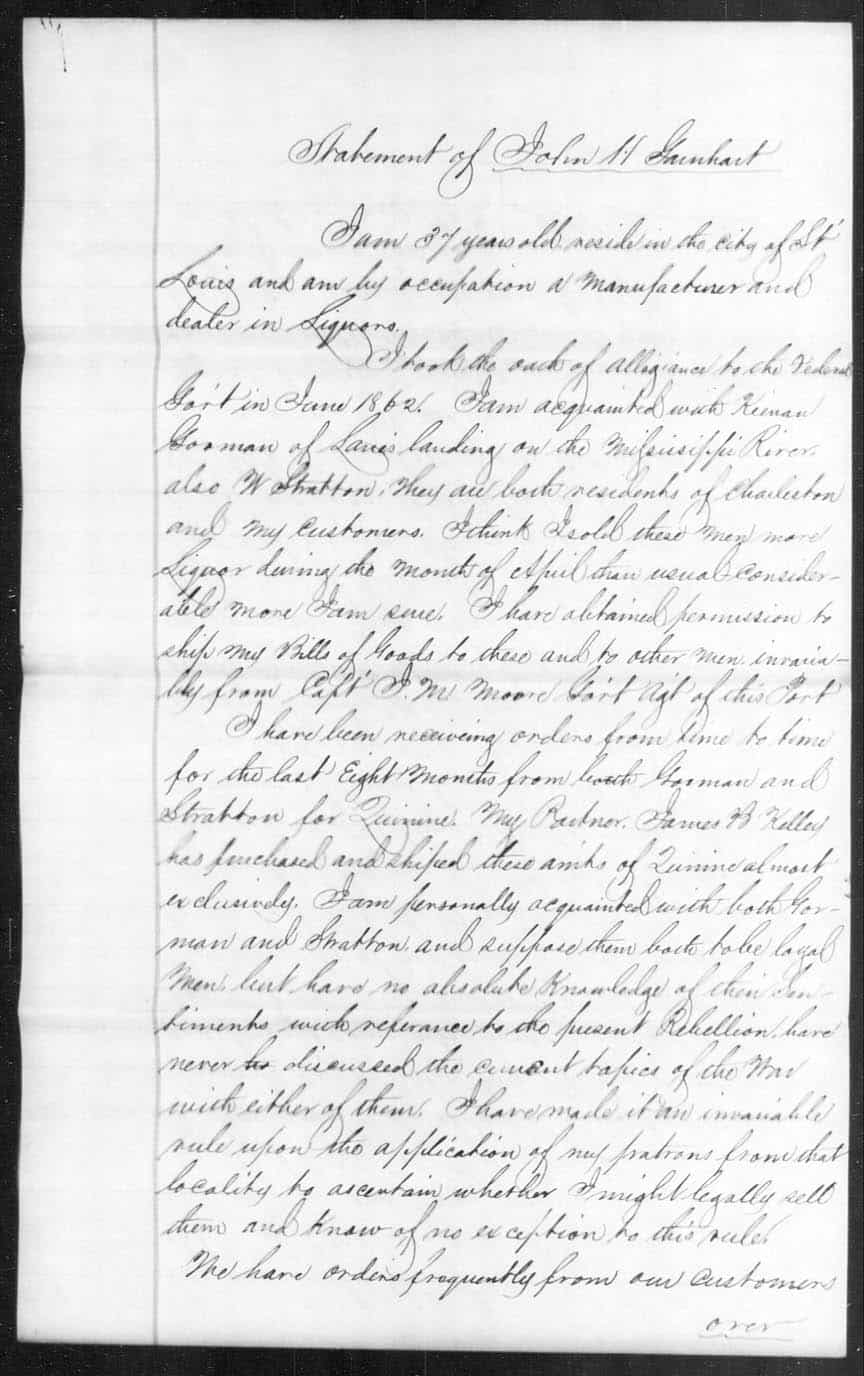
Union Provost Marshals’ File Of Paper Relating To Individual Civilians – 1863 (In this letter, Garnhart mentions his partner James B. Kelley, note spelling of Kelley)
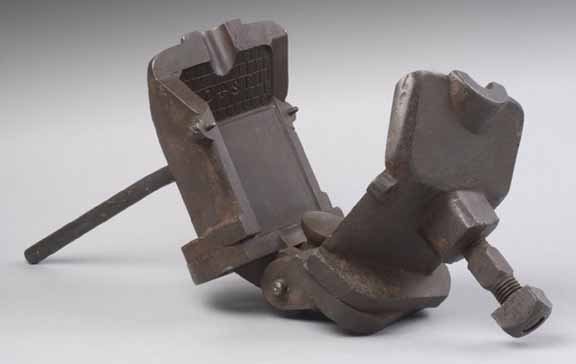
Original Booz treadle type mold in the Philadelphia Museum of Art. The Mold boy has no heavy weight to lift other then the individual articles as they are removed from the mold and placed on the adjoining stand. Mass produced large in size heavy molds such as the Booz Bottle, Kellys Old Cabin Bitters, all of the Calabash flasks and some common whiskey bottles require the use of a treadle mold. The treadle mold is operated by the blower, opening and closing the mold by applying pressure to a lever with his foot. By using this method the mold boys job is much easier as the boys work is limited to removing the bottles from the mold as it is opened by the blower, in which the mold boy becomes a take-out helper rather then a mold boy. – Steve Sewell (Antique-Bottles.net)
Read More: The Best Merry Christmas Bottle Tree
Read More: A Collection of Vintage Christmas Bulbs
Read More: Christmas Themed Glass Post
Read More: Christmas 2011 – Peachridge Glass
![]() Old Taylor Straight Kentucky Bourbon Whiskey was named in honor of Colonel Edmund Haynes Taylor, Jr. (E.H. Taylor) (1830-1923). Taylor was one of Kentucky’s original Bourbon aristocrats and was called the “father of the modern bourbon industry.” He was an industry leader who greatly advanced the quality of Kentucky Bourbon and safeguarded the Bourbon label from bogus producers. Taylor supported and produced some really nice advertising all exemplifying the quality of his product. His picture, Old Taylor Castle, signature and Distillery images occurred on many pieces of advertising throughout 20th century advertising in great magazines like LIFE and LOOK.
Old Taylor Straight Kentucky Bourbon Whiskey was named in honor of Colonel Edmund Haynes Taylor, Jr. (E.H. Taylor) (1830-1923). Taylor was one of Kentucky’s original Bourbon aristocrats and was called the “father of the modern bourbon industry.” He was an industry leader who greatly advanced the quality of Kentucky Bourbon and safeguarded the Bourbon label from bogus producers. Taylor supported and produced some really nice advertising all exemplifying the quality of his product. His picture, Old Taylor Castle, signature and Distillery images occurred on many pieces of advertising throughout 20th century advertising in great magazines like LIFE and LOOK.
I hope you enjoy these images as much as I have. I really enjoy looking at advertising art, typography and styles through various decades.
Read More: Buchanan’s Black & White Scotch Whisky Advertising
Read More: A question regarding an “Old Taylor” find

1935 Old Taylor Bourbon Whiskey advertisement with Paul Revere. Alignment with a famous American historical figure and laying the ground work for putting his signature on every label and advertisement. Both horizontal and vertical signatures present here.
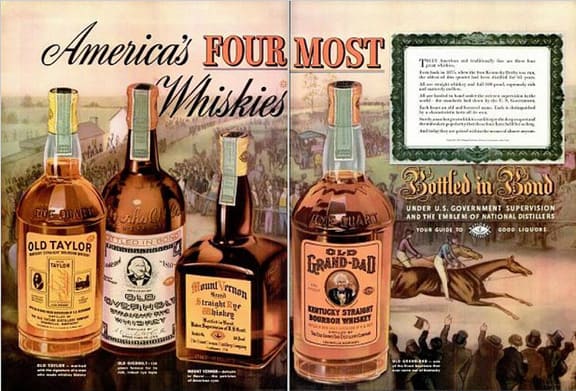
1938 vintage aAdvertisement – America’s Four-most Whiskies: Old Taylor, Old Overhold, Mount Vernon & Old Grand-Dad

1951 OLD TAYLOR KENTUCKY Straight Bourbon Whiskey advertisement. The kentucky horse theme seems to dominate as from this point forwards.
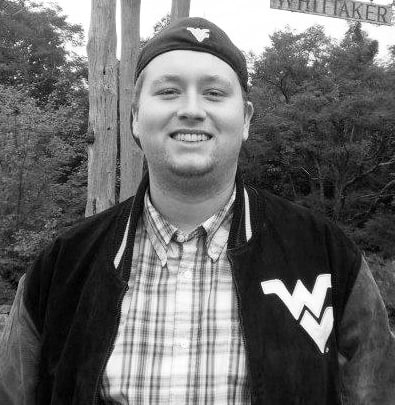 I was wondering if you could do an article on this Old Taylor bottle…maybe figure out where in the heck it came from? Dad wants to know really bad and no one has been able to identify or help him with it. He dug it in a OLD house a long, long time ago. Here it is if you want to do a write-up. Please find some info, that would be amazing. Dad would be really happy for Christmas!! He dug the bottle in the city of White Sulphur Springs, West Virginia or in proximity at least near an old brick Civil War house. Behind the house was a trash dump and he found it there approximately 40 years ago. He also found an anchor flask there and broken bitters bottles.
I was wondering if you could do an article on this Old Taylor bottle…maybe figure out where in the heck it came from? Dad wants to know really bad and no one has been able to identify or help him with it. He dug it in a OLD house a long, long time ago. Here it is if you want to do a write-up. Please find some info, that would be amazing. Dad would be really happy for Christmas!! He dug the bottle in the city of White Sulphur Springs, West Virginia or in proximity at least near an old brick Civil War house. Behind the house was a trash dump and he found it there approximately 40 years ago. He also found an anchor flask there and broken bitters bottles.
The bottle measures 9 1/2″ inches tall, the lip is 1 3/8″ wide and the outer diameter is 10 3/4″+/- and the base width is 3 1/8″. In block lettering in quotations on the front, it says “OLD TAYLOR” then in cursive “SH TAYLOR JR & SONS DISTILLERS, FRANKFORT, KY.”
I’ll have to really work on trying to figure out what that cork reads. I’m thinking it says 1770 but I’m not sure. I sent you a picture of that cork. The top of it does have Taylor written on it and a signature. The base is kind of rough and flat but smooth as well. They found this a long time ago over near that pre-Civil War house that nobody had been living in for a long time – Aaron Hanshew
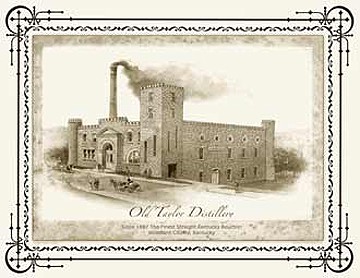 Aaron: What you have pictured is from E. H. Taylor, Jr. & Sons Distillers (not SH Taylor) from Frankfort, Kentucky. I would suspect the bottle is dated around 1884 to 1910 or so as this was when the “Sons” was used on the brand signature. It really could not be in the Civil War era as his sons had not been born. I have been unable to locate any other examples of your bottle.
Aaron: What you have pictured is from E. H. Taylor, Jr. & Sons Distillers (not SH Taylor) from Frankfort, Kentucky. I would suspect the bottle is dated around 1884 to 1910 or so as this was when the “Sons” was used on the brand signature. It really could not be in the Civil War era as his sons had not been born. I have been unable to locate any other examples of your bottle.
Old Taylor Bourbon was named in honor of Edmund Haynes Taylor, Jr. who lived from 1830-1923. Taylor was one of Kentucky’s original Bourbon aristocrats and was called the “father of the modern bourbon industry.” He was an industry leader who greatly advanced the quality of Kentucky Bourbon and safeguarded the Bourbon label from bogus producers. Taylor started and owned seven different distilleries throughout his career, the most successful being the O.F.C. and Carlisle distilleries, the forerunners of today’s Buffalo Trace Distillery.
In 1894, E. H. Taylor, Jr., and his sons, J.S. and Kenner, organized a corporation under the name of “E. H. Taylor, Jr. & Sons”. Soon thereafter their corporation acquired the distillery plant and all other assets of their former partnership and resumed the manufacture and sale of whiskey under the brands “Taylor” and “Old Taylor”. It appears that after 1910 the single word “Taylor” was seldom, if ever, used as the brand name, but thereafter the words “Old Taylor” and the script signature of the corporation “E. H. Taylor, Jr. & Sons” appeared conspicuously upon all labels and in all the advertising matter of the corporation.
His sons were named Jacob Swigert Taylor and Kenner Taylor.

If you look closely, the bottle shape on the bottom right illustration on this Mida’s Criterion document is similar to the Hanshew example. Possibly the handle is behind the bottle and the bottle has a label wrapper.
What is fascinating about Taylor was his guarantee of quality in an industry that had virtually lost all credibility with consumers. He also built the amazing Old Taylor Castle on eighty-two acres along the banks of Glenn’s Creek which is south of Frankfort, in northern Kentucky. This castle was prominent in much of his advertising. The distillery was once the leading bourbon producer of the bluegrass state and was the first to reach the benchmark count of one million U.S. Government certified cases of straight Bourbon Whiskey.
You can also see remnants of the Taylor Distillery and castle if you visit Frankfort or take the Kentucky Bourbon Trail tour.
Taylor was also a descendant of two U.S. presidents, James Madison and Zachary Taylor, and because of this, Taylor had connections to Frankfort that benefited his self-interests. He later served as a longtime, 16-year mayor for Frankfort and as a state representative and senator.
Bottling house at 518 Broadway (1884). Distillers of Old Taylor Whiskey. Distillery at Taylorton, Glenn’s Creek, Woodford Co. (1910, 1912). Distilleries at Taylorton, Glenn’s Creek, Woodford Co. (1914-1919). Taylor also owned the OFC and Carlisle Distilleries near Frankfort.
The company used the brand names: “Carlisle”, “E. H. Taylor, Jr. & Sons”, “J. S. Taylor”, “Kentucky River”, “O. F. C.”, “O. F. C.”, “Old Taylor”, “Old Taylor, A Straight Kentucky Whiskey of Topmost Class”, and “Taylor.”
Business name timeline: E H Taylor Jr. Co. (1884), E H Taylor Jr. & Sons Co. Inc. (1908), E H Taylor Jr. & Sons (1910-1919)
Address timeline: 301 Main (1884), 518 Broadway (1908), 503-511 McClure Bldg. (1910), 503-511 United American Bldg. (1912), 503-511 McClure Bldg. (1914-1919) (Pre-pro.com)
Read More: Old Taylor Distillery
Read More: The Old Taylor Celebration at Buffalo Trace Distillery
Read More: History of the Old Taylor Distillery
Read More: NATIONAL DISTILLERS PRODS. CORP. v. K. TAYLOR DIST
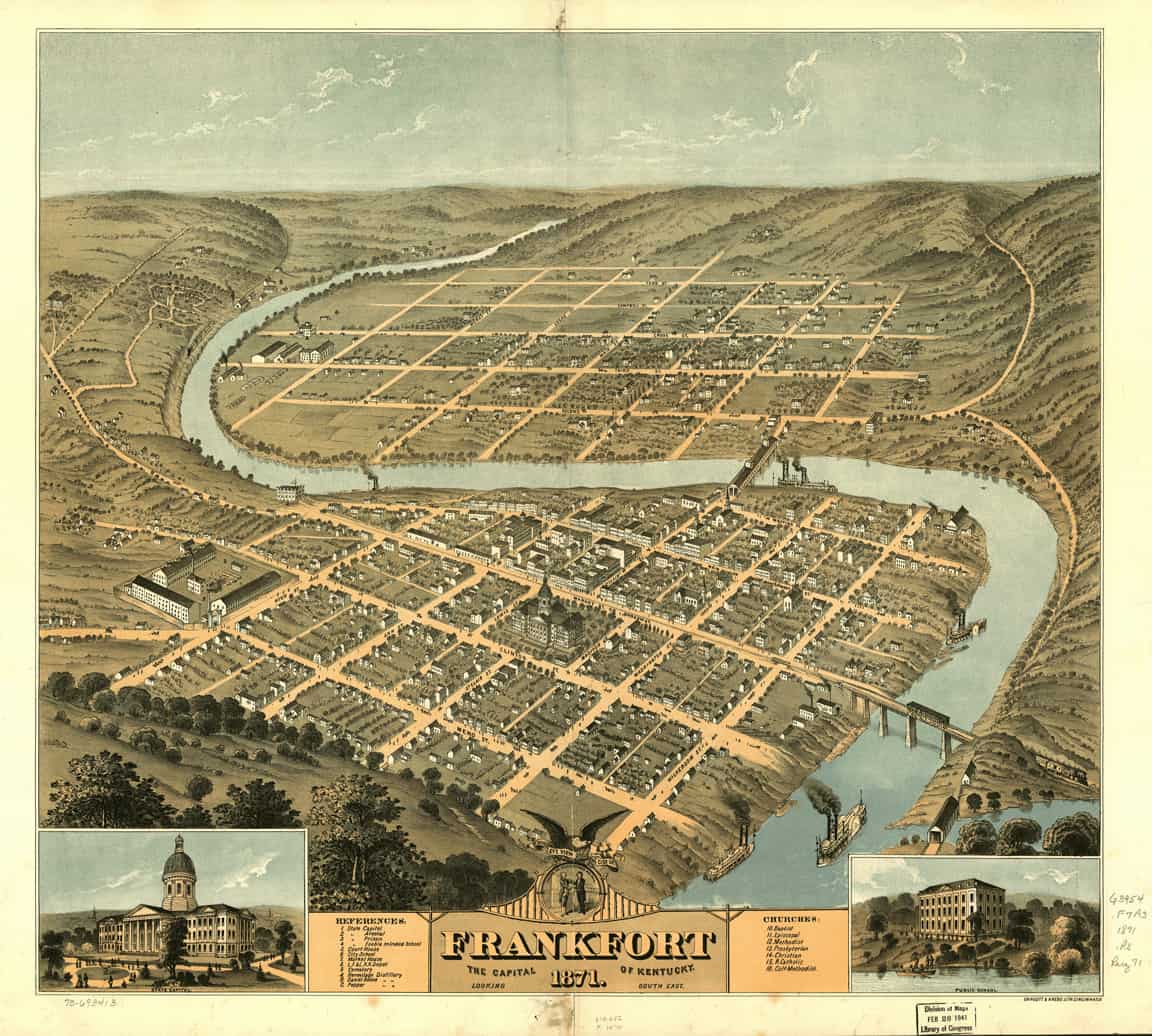
Colonel E. H. Taylor Jr. established the Old Taylor Distillery in 1887 in Frankfort, Kentucky. This was 16 years after this ‘birds eye’ map was illustrated. I think it still gives you an idea of the typography and layout of Frankfort. The Old Taylor Distillery was located south of town on Glenn’s Creek.
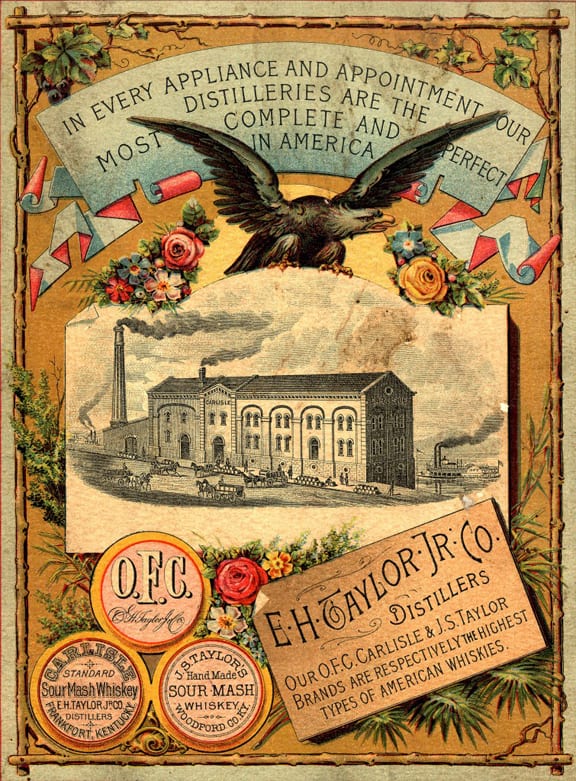
E.H. Taylor Jr. Co. Distillers back book cover in full color. Three products are listed: O.F.C., Carlisle Sour Mash Whiskey and J.S. Taylor Sour Mash Whiskey. This is a rather large distillery for the era. That would be the Kentucky River shown beyond the Distillery.
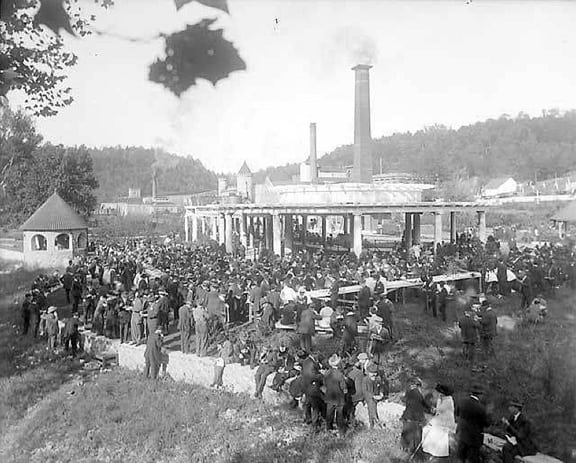
Old Taylor Distillery – “Burgoo for bankers at E. H. Taylor distillery. Crowd at tables in garden area. “
1915 – Kentucky Historical Society
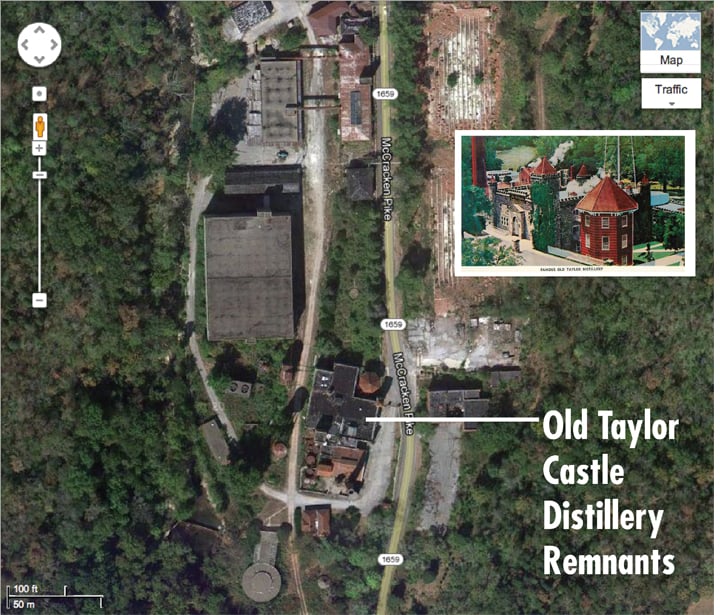
In this Google satellite shot you can see the remnants of the castle, smokestack and round corner tower. This would be a fun site to visit.
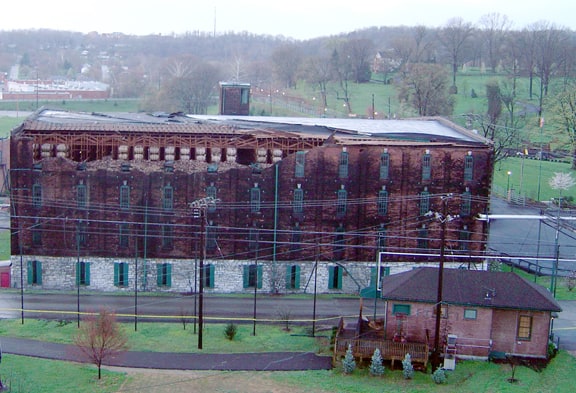
On April 2, 2006, a storm ripped through Kentucky, tearing apart two of Buffalo Trace’s warehouses. One was empty. One, Warehouse C, was full of 24,000 barrels of then-young, far-from-release E.H. Taylor Bourbon.

This odd postcard references a group including Kenner Taylor, one of Col. E.H. Taylor’s Jr.’s sons, purchased what remained of the Baker Distillery at the Forks of Elkhorn in 1933. Their brands included Kenner Taylor, Golden Bantam, and Forks of Elkhorn. Not sure what the dogs are about – Capital City Museum

![]() The Wheeler’s Berlin Bitters is without a doubt, one of my favorite Bitters bottles. Being a native Baltimorean also influences this comment. Unfortunately, I do not know much about the bottle or brand other than what is documented in Ring & Ham (see below) and what has been reported over the years. This hexagonal, pontiled (iron and open pontil) bottle comes in two primary molds and some killer colors. I think most would easily say that this is a Baltimore Glass Works product from around 1850 to 1865.
The Wheeler’s Berlin Bitters is without a doubt, one of my favorite Bitters bottles. Being a native Baltimorean also influences this comment. Unfortunately, I do not know much about the bottle or brand other than what is documented in Ring & Ham (see below) and what has been reported over the years. This hexagonal, pontiled (iron and open pontil) bottle comes in two primary molds and some killer colors. I think most would easily say that this is a Baltimore Glass Works product from around 1850 to 1865.
Usually I look for advertising, labeled examples and genealogy information for the name. In this cast I can find nothing. This is really a puzzler. I am glad the bottle has ‘Baltimore’ prominently embossed on it or I would really be in the dark.
This post represents what is out there now. Hopefully somebody is holding some information so we can unlock the doors and figure out more about the Wheeler’s Berlin Bitters.
Read More: Leading up to Baltimore Glass Works
 Previously Unknown Pair of Whale Oil Lamps Ignite Bidders in Virginia:
Previously Unknown Pair of Whale Oil Lamps Ignite Bidders in Virginia:
A lucky auction staff find from a local estate was a bitters bottle that earned $9,900.
Embossed “Wheeler’s Berlin Bitters Baltimore,” it was a brilliant deep yellow-green, hexagonal form with two blank panels, applied lip and large rough pontil. With a nicely whittled surface, it stood 9 3/4 inches high. – Antiques and the Arts

Baltimore City Map 1850 – The site of the Baltimore Glass Works was on the harbor at Hughes Street (now Key Highway) between Henry and Covington Streets, where its successor company, the Federal Hill Glass Works of Baker Bros. & Co. remained as late as 1873. The wholesale and retail arm of Baker Brothers & Company was located at 32 and 34 S. Charles Street in downtown Baltimore City.
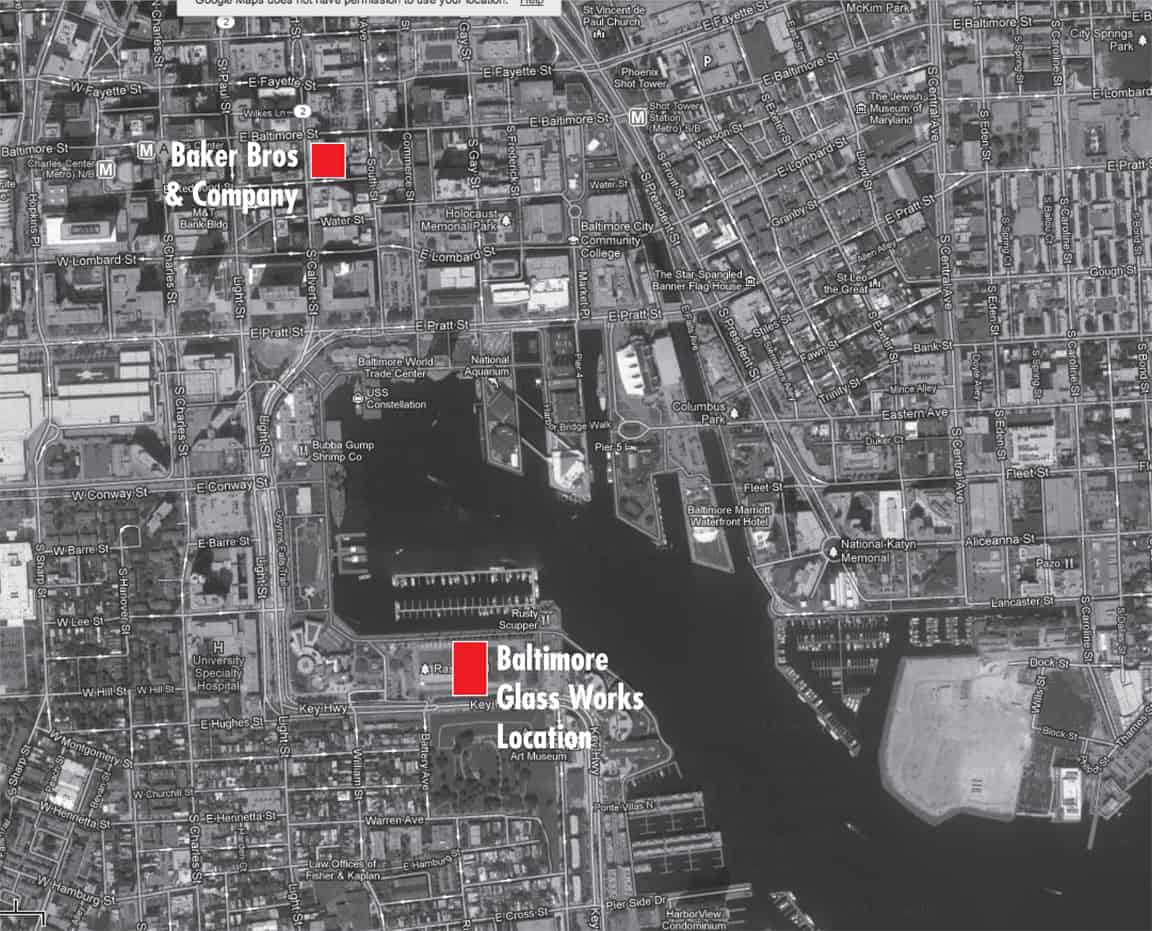
Google Earth Baltimore City 2011 – The site of the Baltimore Glass Works was on the harbor at Hughes Street (now Key Highway) between Henry and Covington Streets, where its successor company, the Federal Hill Glass Works of Baker Bros. & Co. remained as late as 1873. The wholesale and retail arm of Baker Brothers & Company was located at 32 and 34 S. Charles Street in downtown Baltimore City. One can only imagine all of the great bottles under the 20th century skyscrapers, parking garages and new freeways in Baltimore.
The Carlyn Ring and W.C. Ham listing in Bitters Bottles is as follows: